How much money are you wasting by buying new drill bits every time yours get blunt? Chances are, a lot more than you think. Drill bit sharpeners, even the higher-end ones, pay for themselves in the long run. Sharpening your drill bits can save you time, money, and frustration while making your drilling experience safer at the same time.
- What’s the Drill? Buying a Good Drill Bit Sharpener
- Top 10 Best Drill Bit Sharpeners 2023
- 1. Best Overall Sharpener DEWALT DW756 Bench Grinder
- 2. Smallest Benchtop Sharpener: Work Sharp Knife & Tool Sharpener
- 3. Best Budget Sharpener: WEN 4276 Bench Grinder
- 4. Best Premium Sharpener: Tormek T-8 Water Cooled Sharpener
- 5. Best for Professionals: Drill Doctor DD750X
- 6. Best for DIYers: Drill Doctor DD500X
- 7. Best for Beginners: Drill Doctor DD350X
- 8. Best Grinder Jig: General Tools 825 Drill Grinding Attachment
- 9. Best for the Visually Impaired: Woodstock D4144 Drill Sharpener
- 10. Best Drill-Powered Sharpener: Multi-Sharp 2001 Drill Bit Sharpener
- What You Need to Know About Sharpening Your Bits
- The Tipping Point
What’s the Drill? Buying a Good Drill Bit Sharpener
Whether you are a beginner or a professional, sharpening your drill bits is always a good idea; even the best drill bits can be expected to dull with time. Blunt bits need you to apply more pressure to get the same result, creating a higher risk of your drill slipping and ruining the piece or injuring you.
Types of Drill Bit Sharpeners
There are three main ways to sharpen your drill bits: electric bench grinders, specialized benchtop drill bit sharpeners, and drill powered grinders.
Electric Grinders and Jigs
Grinding wheels are incredibly versatile and, as such, are a great addition to any workshop where you need to sharpen a variety of tools, not just drill bits. There is a learning curve to sharpening drill bits to the right angle without a jig or attachment, but it can be done.
If you would like more accuracy, you can purchase a jig or attachment like the General Tools 825 Drill grinding attachment specially designed to set your drill bits at the correct angle for sharpening.
Benchtop Drill Bit Sharpeners
These specialized sharpeners are the easiest to use; once set up, they need minimal adjusting before they are ready to go. Their specialized function and ease of use make them a good option for beginners and professionals alike. If you don’t need the versatility to sharpen other tools, this is a good way to go.
The Drill Doctor DD350X only has one angle setting, which is the one used by all standard drill bits and that the average homeowner is likely to use. You can simply stick in any sized drill bit set at this angle, sharpen for a few seconds, and it’s ready to use again.
A professional would get more use out of the Drill Doctor DD750X, which has a little more versatility in the sharpening angles, accommodating almost any drill bit likely to be used.
Drill Powered Drill Bit Sharpeners
These drill bit sharpeners are generally a cheaper option than the previously mentioned types. They are ideal for use outside of the workshop where you might not have access to a power outlet. They have a similar level of difficulty as using a bench grinder without a jig, and so are a less popular option.
Sharpening Stones
For the old school tool user, you could manually sharpen your drill bits on a whetstone or sharpening stone. This tends to be the most difficult method, however, and is more commonly used for sharpening knives than drill bits, so we haven’t included sharpening stones on our product list below.
Qualities of a Good Drill Bit Sharpener
No matter the type of drill bit sharpener you choose, you should consider the following qualities:
- Compatibility – The sharpener should be able to accommodate a variety of drill bit sizes.
- Abrasive material – A standard grinding stone can sharpen steel and cobalt drill bits, but you will need a diamond wheel for carbide bits.
- Versatility – Drill bits require different angles for different purposes. Can your chosen sharpener create the right angle for your needs?
- Power source – Some drill bit sharpeners plug into a wall socket, others are drill powered. Your choice depends on whether you will be away from the workshop when sharpening.
The last thing to consider is whether you would like a multifunctional sharpener like a grinding wheel, or whether you would be happy using a specialized drill bit sharpener like the Drill Doctor DD500X. This is a personal decision with no right answer—there are pros and cons each way.
Now that you know the drill (bit sharpener), here’s a selection of the best sharpeners on the market for you to consider.
Top 10 Best Drill Bit Sharpeners 2023
1. Best Overall Sharpener DEWALT DW756 Bench Grinder

Editor’s Rating:
Quick Facts:
- Type: Bench grinder
- Power source: Wall socket (110V)
- Motor: 5/8 HP -up to 3,450 RPM
- Compatible with: All drill bit sizes and materials except carbide
- Type of abrasion: Standard grinding wheels – 36 and 60 grit
The DEWALT 6-inch grinder is on the smaller side for grinders but is more than adequate for your home sharpening needs, whether you are sharpening knives, drill bits, or lawnmower blades. It won’t overstep your budget.
As with all grinders, there is a bit of a learning curve to sharpening drill bits accurately. While it’s not necessary, you can use an inexpensive jig or attachment like the General Tools 825 Drill grinding attachment for better accuracy.
One con is that the grinding wheels are not diamond-coated and therefore will not handle carbide drill bits. Additionally, stability is occasionally an issue with this grinder, but the feet are adjustable to help stabilize the machine while you are grinding.
Pros
- Compatible with all drill bit angles
- Good for general home workshop use
- Stable
- Easily fixes damaged bits
- Tool rest to hold bits steady while sharpening
Cons
- Learning curve to get the right angle or additional purchase of a jig
2. Smallest Benchtop Sharpener: Work Sharp Knife & Tool Sharpener

Editor’s Rating:
Quick Facts:
- Type: Benchtop belt grinder
- Power source: Wall socket (110V)
- Compatible with: All steel/cobalt drill bit sizes and types
- Sharpening angle: Any
- Type of abrasion: Standard sanding belts in 4 different grit strengths – coarse, medium, fine, and extra-fine
While the Work Sharp is marketed as a knife sharpener, it is essentially just a small benchtop belt grinder and works the same way as other grinders like the DEWALT Bench Grinder and the WEN 4276 Bench Grinder. Grinders are multifunctional sharpeners making them a fantastic option for those who want to maintain a variety of tools.
It might take some practice to hold your drill bit at the correct angle without a jig or angle guide (see our handy guide to using a grinder to sharpen your drill bits) but it’s easy and quick to set up and use this grinder.
One downside is that the Work Sharp will not sharpen carbide drill bits as these need a diamond wheel and the grinding belt on this sharpener is not strong enough. The Drill Doctor DD750X is a better option if you use carbide drill bits.
Pros
- Multifunctional sharpener
- Quick and easy setup and use
- Compatible with all steel/cobalt drill bit sizes and types
- Versatile – can be used for all drill bit angles
Cons
- No available jig or angle guide for drill bits
- Not compatible with carbide drill bits
3. Best Budget Sharpener: WEN 4276 Bench Grinder

Editor’s Rating:
Quick Facts:
- Type: Bench grinder
- Power source: Wall socket (110V)
- Motor: 2.1 Amp – up to 3450 RPM
- Compatible with: All drill bit sizes and materials except carbide
- Type of abrasion: Standard grinding wheels – 36 and 60 grit
If you don’t want to make a big investment in a grinder and plan on only using it occasionally to sharpen smaller tools, like drill bits, this bench grinder is a great option. The motor does struggle slightly with heavier loads, and larger items like lawn mower blades will slow the wheels. The Tormek T-8 is a better option if you need a multifunctional grinder that can also handle larger items.
As it is a grinder, you can sharpen at any angle, although there is a slight learning curve to do this freehand. Alternatively, you can use it in conjunction with a jig or angle guide like the General Tools 825 Drill grinding attachment.
Unlike other grinders, the WEN 4276 comes with an adjustable work light to help you better see the items you are working on. Occasionally the neck of the light is weak and needs adjusting. While this isn’t a major issue, it can be frustrating.
One con is that the wheels are not always balanced, which can cause the grinder to wobble or “walk” around your work surface. In this case, you may need to ask for a replacement grinder.
Pros
- Multifunctional – sharpens a variety of tools
- Compatible with all drill bit angles
- Can be bolted to the workbench for more stability
- Work light for better visibility
Cons
- Motor struggles with heavier loads or large items
- Occasionally unbalanced wheels

Editor’s Rating:
Quick Facts:
- Type: Bench grinder
- Power source: Wall socket (115V)
- Motor: 100 RPM
- Compatible with: All drill bit sizes and materials except carbide
- Type of abrasion: Standard grinding wheels – 220 to 1000 grit
While much more expensive than the DEWALT DW756 or the WEN 4276 bench grinders, this grinder has much more finesse and is specially designed for sharpening edge tools like knives, chisels, and drill bits. It runs at a slower speed than most grinders which, combined with the water-cooling system, allows you to get a much sharper edge without the risk of overheating your tool edges, which can soften them. It also comes with an amazing 8-year warranty, which is a testament to its quality.
Depending on the tools you want to sharpen, there are several jigs and attachments available, including a drill bit sharpening jig, but these must be purchased separately.
Pros
- 8-year warranty
- Water-cooled to avoid overheating your tools
- Multifunctional – sharpens all edge tools
- Fine grit for honing edges
- Compatible with all drill bit angles
Cons
- Learning curve to get the right angle or additional purchase of a jig
- More expensive
5. Best for Professionals: Drill Doctor DD750X

Editor’s Rating:
Quick Facts:
- Type: Benchtop drill bit sharpener
- Power source: Wall socket (120V)
- Compatible with: All drill bit types, sized between 3/32” and 3/4”
- Sharpening angle: Adjustable between 118° to 140°
- Type of abrasion: 180 grit diamond wheel
No matter what type or size drill bit you have, this machine can sharpen it.
While the average homeowner doesn’t require specialized sharpening just for drill bits, if you use your drill often and for a variety of purposes, this might be just what you need for quick and easy maintenance of your equipment. There’s no need to set up a jig or attachment to get the right angle like on a grinding wheel, making it super easy to use.
You can adjust your angles slightly for different bits as needed, and the diamond wheel ensures a sharp edge for all bit materials. Unfortunately, the diamond wheel only has one grit size; this is fairly coarse and can heavily grind your bits. You can get wheels with different grits but they must be purchased separately.
The biggest issue with the DD750X is that the split point grinder is difficult to use and doesn’t add much to the sharpener.
Pros
- Easy to use
- Compatible with all drill bit sizes and types
- Diamond wheel compatible with bits of all materials
- Sharpens left-handed/reverse drill bits
Cons
- Only comes with one grit size
- Split point grinder is difficult to use
6. Best for DIYers: Drill Doctor DD500X

Editor’s Rating:
Quick Facts:
- Type: Benchtop drill bit sharpener
- Power source: Wall socket (120V)
- Compatible with: All drill bit types, sized between 3/32” and 1/2”
- Sharpening angle: 118° or 135°
- Type of abrasion: 180 grit diamond wheel
This model is very similar to the Drill Doctor DD750X. The main differences are that it is only slightly more restrictive on the size drill bits that it can accommodate, and it has two set angles rather than adjustable angles. However, most drill bits you’re likely to come across will be compatible with this sharpener, so it’s not much of an inconvenience unless you work with non-standard bits.
As with the DD750X, the DD500X sharpener uses a diamond grinding wheel that can be used with drill bits of all materials. Only one 180 grit diamond wheel is provided but you can purchase different grits separately.
One con is that the sharpener cannot be attached to a workbench, which compromises the stability when sharpening.
Pros
- No setup - easy to use
- Compatible with most drill bit sizes and types
- Diamond wheel compatible with bits of all materials
- Sharpens left-handed/reverse drill bits
Cons
- Split point grinder is difficult to use
- Unstable as sharpener cannot be attached to the workbench
7. Best for Beginners: Drill Doctor DD350X

Editor’s Rating:
Quick Facts:
- Type: Benchtop drill bit sharpener
- Power source: Wall socket (120V)
- Compatible with: All standard drill bit types between 3/32” and 1/2”
- Sharpening angle: 118°
- Type of abrasion: 180 grit diamond wheel
While this is a smaller model of the Drill Doctor DD750X and the Drill Doctor DD500X, it is a great option for beginners and homeowners who primarily use standard drill bits for DIY projects.
Most commonly used drill bits are sharpened to a 118° angle and will drill into common materials like wood, aluminum, and plastic. You are unlikely to use drill bits with other angles unless you are a professional and/or need to drill into very hard or tough material.
While it can accommodate smaller drill bits, it struggles to hold them in place to accurately sharpen to the correct angle. The sharpener works much better with the medium to larger bit sizes.
Pros
- No setup – easy to use
- Great choice for beginners and home users
- Compatible with most standard drill bits
- Diamond wheel compatible with all drill bit materials
Cons
- Not compatible with left-handed/reverse drill bits
- Does not sharpen split points
- Struggles with smaller bit sizes
8. Best Grinder Jig: General Tools 825 Drill Grinding Attachment

Editor’s Rating:
Quick Facts:
- Type: Drill bit sharpening jig/grinder attachment
- Power source: None
- Compatible with: All standard drill bit angles and sizes
- Type of abrasion: None
If you already have a bench grinder or are planning to get one like the DEWALT DW756, a drill bit sharpening jig like this one will help you accurately set the angle you need on your bits. It is essentially a specialized angle gauge that will work with most grinders and belt sanders. On the downside, a jig is not the only sharpening equipment you need and it can be costly to buy a grinder unless you have other tools you also need to sharpen.
Having a jig eliminates some of the difficulty in getting the right angle that you face when sharpening drill bits by hand, but it can be tricky to make sure both sides of the bit are consistent.
The instructions provided with this jig are unclear and poorly printed but there are instructional videos available showing how to set up and use it.
Pros
- Works with most bench grinders and belt sanders
- Compatible with all drill bit sizes
- Can be set to all standard drill bit angles
Cons
- Not a complete sharpener, must be used with a grinder
- Provided instructions are unclear
- Difficult to keep the sharpening angle consistent on both sides
9. Best for the Visually Impaired: Woodstock D4144 Drill Sharpener

Editor’s Rating:
Quick Facts:
- Type: Drill bit sharpening jig/grinder attachment
- Power source: None
- Compatible with: All standard drill bit angles and sizes
- Type of abrasion: None
This jig works in the same way as the General Tools 825 Drill grinding attachment and must also be paired with a bench grinder like the DEWALT DW756 bench grinder or a belt sander.
A huge benefit of having a jig is that you no longer have to guess the correct angle for sharpening your drill bits, which is a relief if you have trouble with your eyesight.
The Woodstock jig occasionally arrives with an unsteady stand which can compromise your sharpening edge. In addition, the locking screws are quite small and fiddly to use which can be frustrating.
Pros
- Works with most bench grinders and belt sanders
- Compatible with all drill bit sizes
- Can be set to all standard drill bit angles
Cons
- Not a complete sharpener, must be used with a grinder
- Stand is unsteady
- Small screws that are difficult to set in place
10. Best Drill-Powered Sharpener: Multi-Sharp 2001 Drill Bit Sharpener

Editor’s Rating:
Quick Facts:
- Type: Drill-powered drill bit sharpener
- Power source: Drill
- Compatible with: Standard drill bits of all sizes and materials
- Sharpening angles: 118° to 135°
- Type of abrasion: Aluminium oxide and silicon carbide grinding wheels
This drill-powered sharpener is a good option for those who don’t have a workshop, as well as for people who often work outside. It is portable and can be set up wherever you have your drill. As it’s essentially a mini grinder, you can use it to sharpen all standard drill bits to the correct angle, as well as knives and other small tools.
This sharpener isn’t quite as heavy-duty as the DEWALT DW756 bench grinder and we do find the wheels wear quickly. Still, the wheels can be replaced easily, and we see this as a fair trade-off for the portability it offers – especially for the budget-friendly price.
Some cordless drill users may struggle with the fact that they are left with only one free hand to manage the drill bit and sharpener, which can be tricky to coordinate. Of course, if you’re using a mains-powered device this won’t be an issue.
Pros
- Portable – easy to use in the field
- Compatible with all standard drill bit sizes and materials
- Multifunctional – can also sharpen knives and other small tools
Cons
- Wheels can wear down quickly
- Requires one-handed operation (if used with cordless drill)
What You Need to Know About Sharpening Your Bits
Each sharpening tool uses a different method, and you can get lost in the wealth of information provided for each one. The important thing is that you choose the one that works best for you and your lifestyle.
Recognizing Dull Drill Bits
We often continue using dull tools longer than necessary, either because we haven’t noticed the signs of bluntness yet, or because we want to finish the job before stopping to sharpen. While the latter is understandable, it can be dangerous and places unnecessary strain on your tools and yourself.
Your drill bits are getting dull if you notice:
- That you need to put more pressure on the drill to bite into the material,
- Smoking or dark brown shaving when drilling wood,
- Dust rather than small chips or shavings being produced,
- Uneven or off-center holes.
You might also notice chips or dents on your bits that need to be smoothed out. A bench grinder is often best for this purpose but it can be done on a Drill Doctor DD500X; it will just take a little longer.
Which Angle Do I Need?
Drill bits are used for creating holes in a variety of materials. The angle of the tip of the bit, known as the point angle, needs to be suited to your task to attain the best efficiency while drilling.
There are three main point angles found in commonly used drill bits:
- 90 degrees – mainly used for very soft materials like softwood, plastic, rubber, and aluminum.
- 118 degrees – for most materials you’ll deal with, including wood, brass, cast iron, and plastic.
- 135 degrees – for harder metals like steel and stainless steel.
The steeper angles (less than 100 degrees) are better for soft materials as they tend to dull quickly when used on harder materials. Shallower angles, like the 135-degree bits, bite into harder materials without dulling as fast. However, they do tend to “walk” or move around, so you’ll probably need to start by using a center punch or a drill press to help the drill bit stay where it’s supposed to.
Split Points
Many 135-degree drill bits, and some 118-degree bits, have a split point. Split point drill bits have small grooves cut into the point which allows the bit to cut into the material with less pressure than a standard drill bit needs and lessens the need for a center punch to prevent walking. It can be tricky to create a split point when sharpening your drill bits unless you have a specialized sharpener like the Drill Doctor DD750X or DD500X. Split points are not necessary but can be very useful, especially if you work with hardwood and rare materials that you don’t want to damage while drilling.
Why Do You Sharpen at 60 Degrees?
In most instructional articles or videos, the person talks about sharpening their drill bit at a 60-degree angle. While this is confusing given the general angles discussed above, the simple answer is that 60 degrees is roughly half of 118 degrees. They are sharpening one side of the bit point at a time.
This is also the best way to sharpen masonry drill bits that have a slightly different point shape to other drill bits.
How to Sharpen Drill Bits on a Grinder
Sharpening drill bits on a grinder requires a bit of technical knowledge. While Drill Doctors are a lot simpler and come with operating instructions, they work a little like a fancy pencil sharpener. Here’s how to sharpen your drill bits on a grinder.
Safety First
While some grinders like the DEWALT DW756 come with protective coverings, it’s generally a good idea to use protective equipment like gloves and safety glasses. The glasses protect your eyes from sparks and small shavings that might come off while grinding.
The choice to use gloves depends on how and what you are using to sharpen your bits. Some say the gloves protect your hands from the heating process that happens as you grind; others say that it’s more dangerous to wear gloves as they can get caught on the grinding wheel and cause an injury.
Your drill bits should not be getting too hot anyway, as this can damage them and make them brittle. By not wearing gloves you can check if your drill bit is starting to overheat and cool it in water before it gets too hot.
A general rule of thumb is, if you are wondering whether you should be wearing safety equipment, the answer is yes.
Using a Bench Grinder
If this is the first time you are using a bench grinder to sharpen your drill bits it’s a good idea to practice using your oldest drill bits, or cheap second-hand bits from a pawn shop that you’re okay messing up a little. It might take a few tries to get it just right.
When you are ready, set up your grinder and follow these steps:
- File down any burs. These can cut you if the drill bit slips in your hand while sharpening.
- Make sure your tool rest or guard is less than 1/8” from the grinder so your bit can’t get caught in it.
- Hold your bit at a 60-degree angle to the side or face of the grinder using the edge of the drill bit point as a guide. The cutting edge should be facing outwards.
- Hold the drill bit against the grinding wheel, rotating the tip downward slightly as you do so. For simpler sharpening, omit the rotation. It is unnecessary but creates a rounded edge that can help the bit cut into the material more easily.
- Repeat this movement twice.
- Rotate the drill bit 180 degrees and repeat steps 3-5.
- Cool your drill bit in some water between passes to avoid overheating and damaging your bit.
Once you have followed these steps, look down the drill from above to make sure the drill bit is centered correctly. You might need to repeat the process a few times to properly align the center. Here’s a handy video to provide a visual aid for the process from start to finish.
Pro Tip: If you don’t have a protractor or other device to measure angles, you can check the angle by putting two hex nuts together. This creates a handy 120-degree angle to which you can compare your drill bit.
To sharpen a drill bit to 135 degrees, follow the same process but use a 67- to 70-degree angle instead. As with the 118-degree drill bits, you can use the current angle of the drill bit as a rough guide.
A Bit of Advice: Maintaining Your Grinder or Drill Bit Sharpener
Like any equipment, your grinder or sharpener will last a long time if looked after well. No matter which method you are using, clean away metal filings with a damp cloth to avoid rusting on your machine. You should also oil moving parts regularly to lessen any strain placed on them.
Replace the grinding wheels when they are losing their efficiency. On a Drill Doctor, this is around every 200 uses, while a larger wheel on a grinder will usually last much longer. If the wheel on your grinder looks worn smooth or one side has worn down more than the other, making it unevenly balanced, it should be replaced.
To avoid uneven wear on your grinding wheels, move the drill bit or other tool edges left to right as you sharpen.
The Tipping Point
Sharpening and maintaining your tools is a fantastic way to save time and money that you might have spent replacing blunt or damaged tools like drill bits. Although there are several different methods to accomplish this, the result is the same.
Bench grinders are useful to have in a workshop as they can sharpen and fix a variety of tools, not just drill bits. However, they are more difficult to use than a specialized sharpener like the Drill Doctors. Your choice of which type of sharpener to use depends on how often you need to sharpen drill bits and whether you would get more use out of a multifunctional tool like a grinder.
